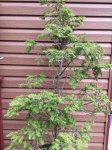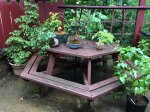TSUGA CANADENSIS/ Eastern or Canadian Hemlock
A broadly conical tree to 25 metres tall in its native eastern North America. T. canadensis has linear finely-toothed, mid-green leaves to 2cm that taper from their bases and are 2-ranked. There are many varieties of Tsuga canadensis available including dwarf and prostrate forms. Frequently seen is Tsuga canadensis 'Jedoloh' which has a common name of 'Birds Nest Tree because of its habit of spreading and forming a depression in the crown that resembles a birds nest.
TSUGA HETEROPHYLLA/ Western Hemlock
Narrowly conical tree with narrowly-oblong, finely-toothed, glossy dark-green leaves 0.5-2cm long which are 2-ranked. Native to west North America (Alaska to California) where it can reach heights of 20-40metres. (Extremely shade tolerant but requires extra shelter from the wind).
TSUGA DIVERSIFOLIA /Japanese Hemlock
Broadly conical, later domed tree, orange bark and orange shoots with short, fine hairs. Linear leaves are very glossy, dark-green, 0.5-2cm long and 2-ranked. Native to north Japan where it can reach heights of 15metres.







